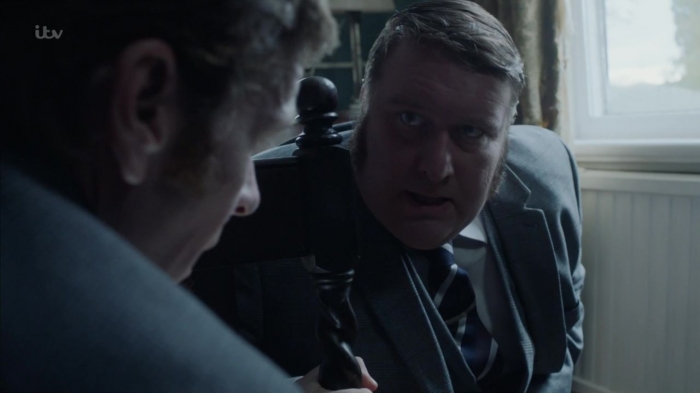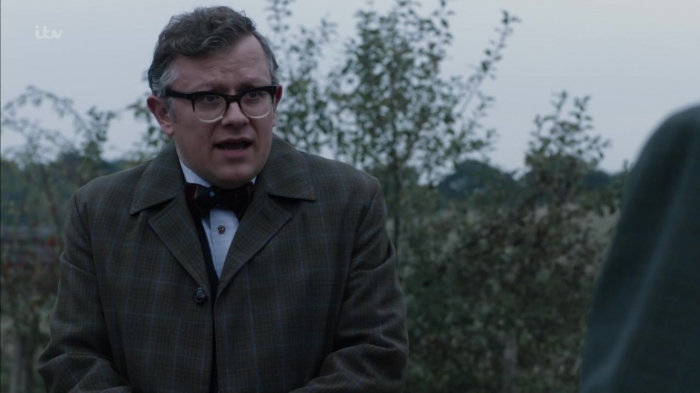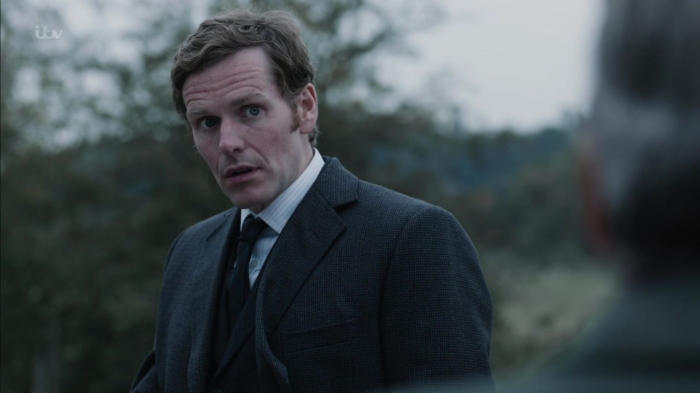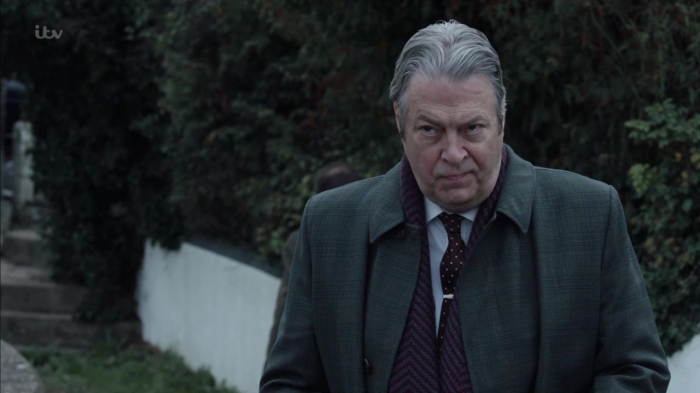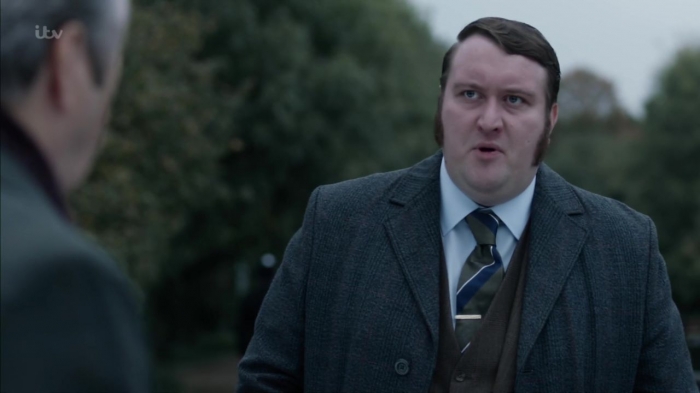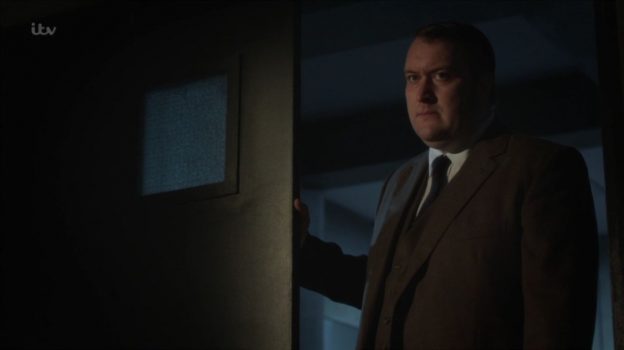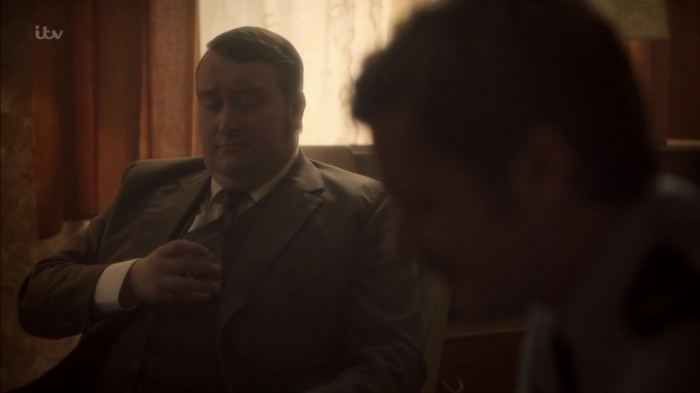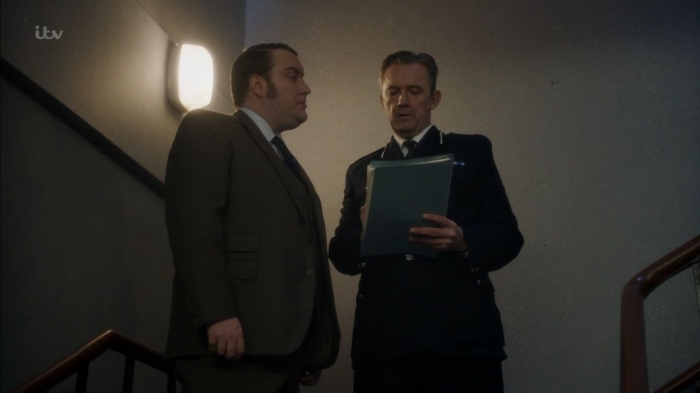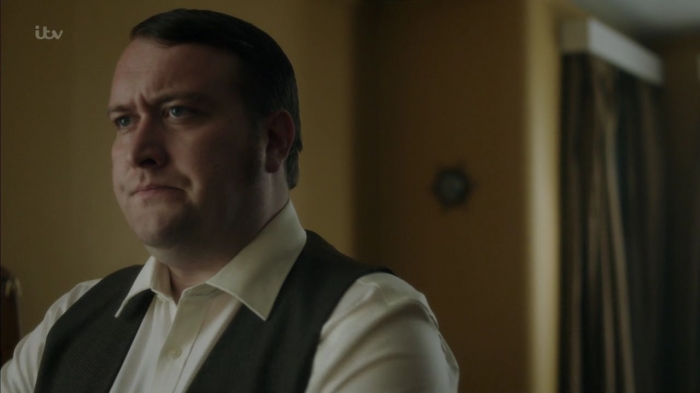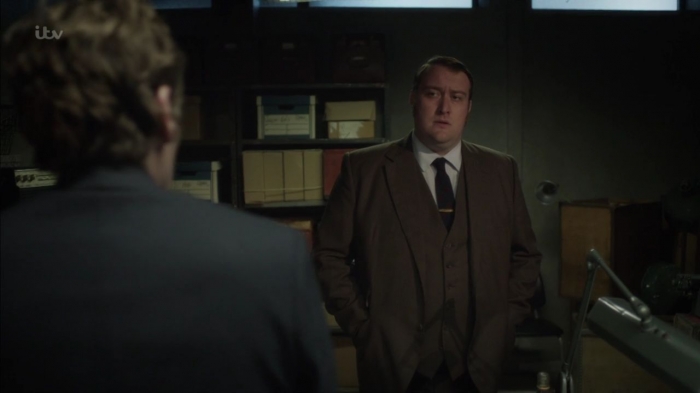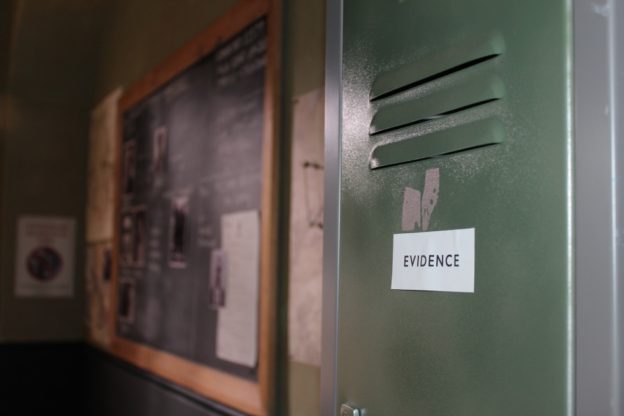PREVIOUSLY…
We meet at the train station where the tannoy system blasts out its arrivals and departures but, as I notice his car parked and waiting for me outside the booking office, all I hear is Rachmaninoff’s Piano Concerto No. 2…
DAMIAN: Morning Lewis, much in? Oh, before I forget, Dolly Messiter sends her regards. Now then, tell me a little bit about Endeavour HQ and how long you’ve been based there.
RUSS: We’ve been at a place called Wilton Park – a former Tri-Services Language School in Beaconsfield – since Series 3 — so… three years, more or less. Our standing sets – Cowley nick; Strange and Endeavour’s flat; the Thursday house; mortuary, &c. — are housed in a couple of buildings. The gymnasium – having the most floor space – taking the lion’s share. However, our current home is now being redeveloped so – should we return – we’ll be looking for a new base to house those sets…
If you the missed the first part of this set report you can catch up with it here: Set Report Part I
~
195: PART II
An Exclusive ENDEAVOUR Set Report
Article, interviews & photographs copyright © Damian Michael Barcroft 2018
~~~
Walking into the main building, we soon find ourselves standing in what was a large gymnasium and there are various clues providing evidence of its previous purpose including a retractable basketball goal suspended from above, a climbing wall to the left, some wooden gym benches scattered about and a sad, solitary pommel horse looking rather lost and out of place among all the camera and lighting equipment that has been set up for today’s shooting of the final episode of series 5 on this penultimate day of filming.
In the centre stands what looks similar to, at least in its approximate dimensions, a mobile home but one made of wood and propped up by various coulisses or flats. The entrance is fitted with two wooden doors with aquatex or minister-type glass windows but as we open them to walk inside, this almost surreal scene soon becomes much more familiar upon seeing the corridor complete with noticeboard warning, quite poignantly and with a sense of foreboding considering a certain future remorseful day, excessive drinking can cause serious illness.
 Taking a few steps further along the corridor and then turning right, there’s a locker marked “evidence” and a crime board behind with various mugshots. I am, of course, now standing in CID, Cowley Police Station, the home and heart of Endeavour with its writer and executive producer, Russell Lewis.
Taking a few steps further along the corridor and then turning right, there’s a locker marked “evidence” and a crime board behind with various mugshots. I am, of course, now standing in CID, Cowley Police Station, the home and heart of Endeavour with its writer and executive producer, Russell Lewis.

Strange’s desk

You might want to pay particular attention to the names listed here.
DAMIAN: That’s Strange’s desk in front of us, Endeavour’s to the left of his and Thursday’s office behind that. Although I now realise that Bright’s office is in a completely separate building in real life, where do you imagine it to be in your head and in relation to where we are now?
RUSS: Around the corner.
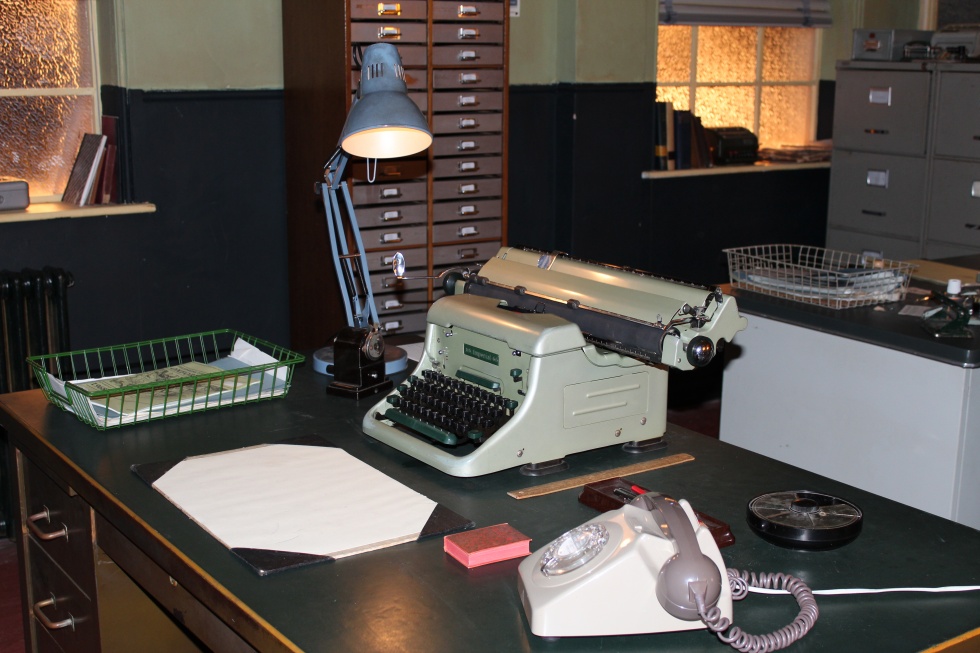

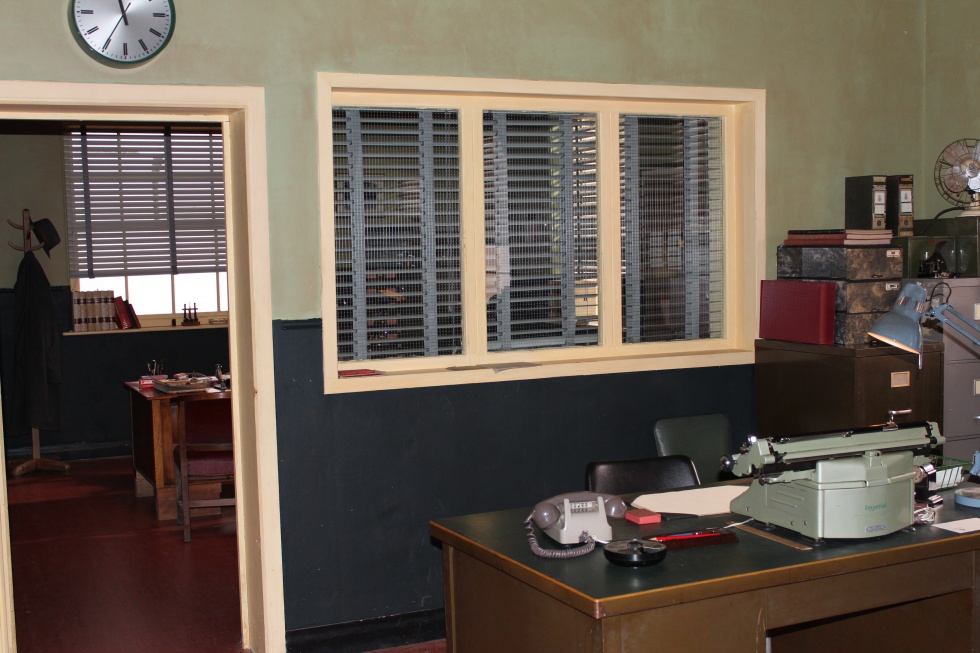
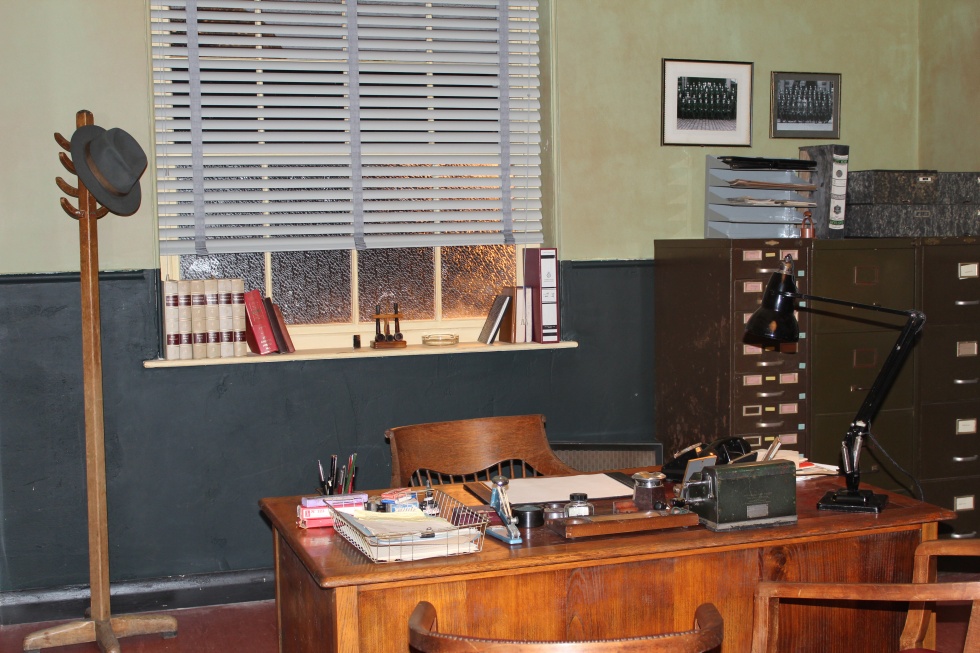
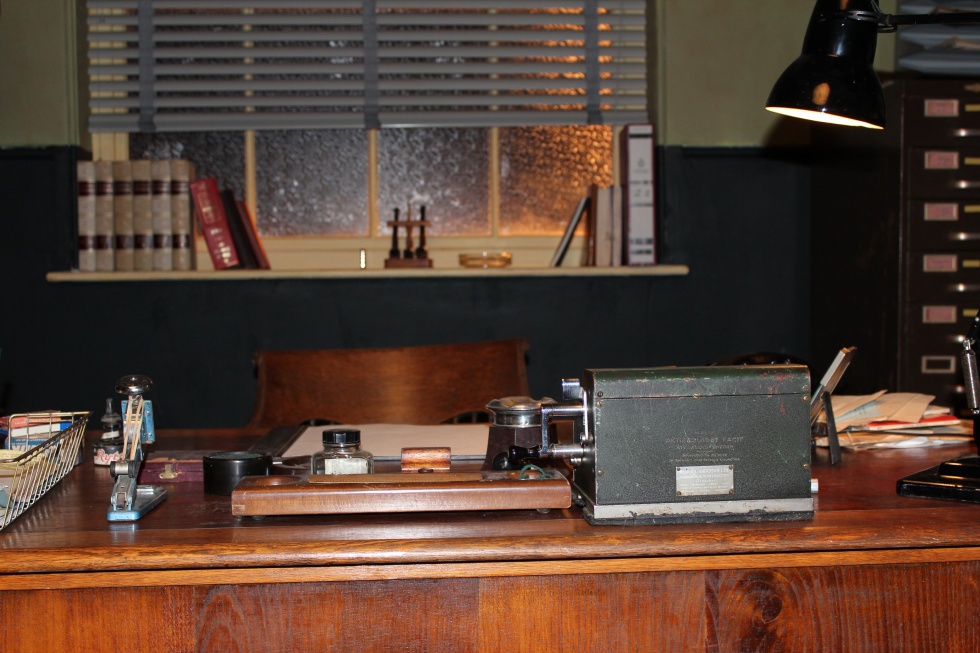
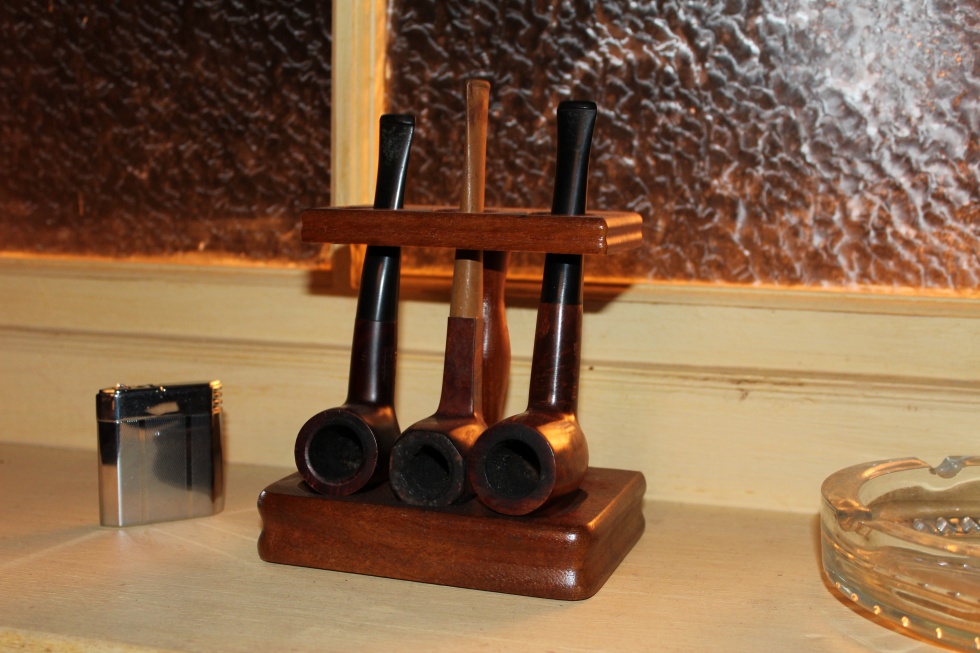 DAMIAN: When you’re writing a scene at home, and let’s use Thursday’s office as an example, do you see a computer screen splashed with courier font or do you actually see Roger Allam, his fedora hanging on the hatstand next to him and all the little details such as the pipe stand, lighter and ashtray?
DAMIAN: When you’re writing a scene at home, and let’s use Thursday’s office as an example, do you see a computer screen splashed with courier font or do you actually see Roger Allam, his fedora hanging on the hatstand next to him and all the little details such as the pipe stand, lighter and ashtray?
RUSS: That’s the devil of a question. Because it’s really ‘how do you write a scene?’ It’s difficult to describe something instinctive. And also tricky to describe a process one doesn’t analyse in the moment without sounding absolutely crackers. You’re in the Twilight Zone. A sort of disassociated mental state. The physical act of moving fingers over keys is more or less unconscious. I can hear Rog being Thursday, or Shaun being Endeavour in my mind’s ear. There’s probably two or three points of visual focus — the screen; a space about a foot in front of one’s head – midway between the eyes and the screen; and maybe off to the side. One of the things said about lying is that people look to the right when constructing a falsehood, or look to the left when recalling an actual event. Writing a scene – you’re creating something fundamentally untrue, but you have to believe in it to make it credible. So… I said it was hard to describe — you’re working in an arena of feeling, rather than something you see in your mind’s eye. You feel the scene – from each character’s point of view. Slipping between one and the other or however many of them there are in the room. You’re all of them at the same time — and still in control of directing what they say and do. So – as I’m writing a Thursday line, I’m already aware of what Endeavour will say in reply – and back to Thursday, and so forth. But the process is a kind of conscious and focussed dreaming. A performance – of sorts. Private – mercifully – and it would be very boring to watch. But a performance all the same. You just attack it line by line. Get it down. Some scenes write themselves — others… it’s pulling teeth.
I’ll let the characters run on. Find out what they’ve got to say. You might write a speech of half a dozen lines until you find the thing that character’s really trying to say. Often it’s the thing you’ve been fighting against letting them say. Because – in the end, they’re all extensions of one’s personality – aspects of it at least. And that’s what you’re resisting. Exposing yourself – emotionally. All those places one would sooner not go. You have to dredge them up and put them on the page.
As I’ve said before, most of the time it’s the other guy that slips behind the wheel. The dark passenger. He’s the real brains of the outfit. I just do the typing. None of which is helpful, I’m sure. So – apologies if this isn’t a particularly illuminating answer to your question, but it’s not something I think about overmuch.
The closest comparison I can make is to a jazz solo. It’s an extended improvisation that happens in the moment. There’s technique and experience behind it — but one has to transcend all that, forget it almost, not reach for the riffs that live in muscle memory and fall easily under the fingers — you have to reach for something new, and make it truthful. Speak from the heart, not the head.
You probably won’t find this stuff in McKee.
DAMIAN: It sounds like I’m taking the Michael but I’m genuinely not, do you ever explore or experiment with a line, perhaps particularly some of Thursday’s magical idioms, by saying them aloud to yourself before writing them?
RUSS: Rarely. You develop an ear, I suppose. It helps perhaps that I came to it from the other side of the camera. You know by experience and instinct whether a line will play or not. It’s in your bones. But you don’t need to say it aloud — you can hear the intonation and phrasing – the beats and stresses – the music of the line – in your head. It’s something I remember doing as a kid – I think all kids do it. Play acting. Who wants to play Lost In Space? Or Land of the Giants. I’ll say this — and then you say that. I certainly remember that being part of the playground. Those breaktime visits to Bucks Fizz’s ‘Land of Make Believe.’
Elementary writing and direction, perhaps. You see them do it with toys – playing with dolls and GI Joe or Action Man or whatever — they have them ‘talk’ to each other. That’s either something from life, or something they’ve seen on the box. The toys recreate a scene. This one says this — that one says that. And the thing being mimicked is expanded upon with a new line or a bit of business. Doubtless that’s an evolutionary mechanism that serves a developmental process – learning and experimenting with language – playing with thoughts and emotions. Now the dolls are fighting, now they’re being friends.
Spielberg was right. If you ever got down to floor level with your toy soldiers, closed one eyed, and look at a battlefield from the perspective of one of those toy soldiers — that is instinctive directing, and probably cinematography too. That impulse. Or perhaps children are just certifiable. The walls between fantasy and reality – magic thinking – seem very thin at that age. Maybe those that work in a creative line hang on to some part of that. At least they keep a key that opens the door to that world.
DAMIAN: I’m presuming that directors don’t just turn up improvising where to put the camera but rather that there is a certain amount of shots that are planned in advance. Therefore, I wonder if directors get to see the set beforehand because the design and setup would exclude certain shots such as a continuous “walk and talk” from here to Bright’s office for example?
RUSS: Oh – absolutely. Directors typically come on with five weeks Prep, across which time — if they’re not already familiar with the show — they’ll acquaint themselves with the topography of the standing sets. I would think 75% of what we do is not at base, though. Which is where the various Recces and Tech Recces are invaluable. You should talk to our directors – get the skinny first hand.
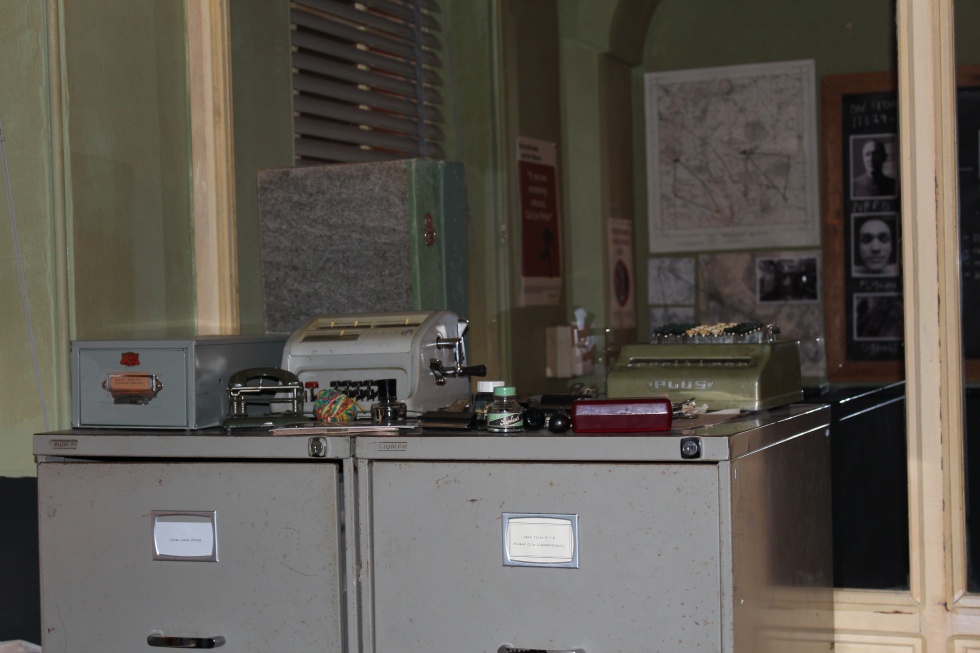



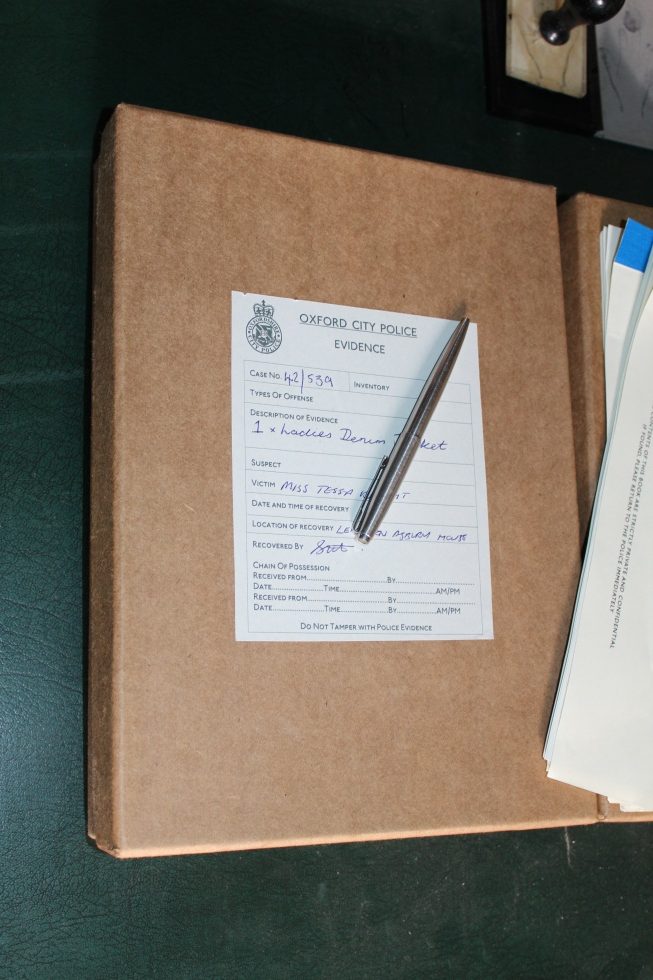
 DAMIAN: CID in particular, with all its wonderful props, must be one of the most frequented rooms inside your memory palace. I wonder if, in some peculiar way, it almost feels like home?
DAMIAN: CID in particular, with all its wonderful props, must be one of the most frequented rooms inside your memory palace. I wonder if, in some peculiar way, it almost feels like home?
RUSS: It’s a fun place to visit – but I wouldn’t want to live here. I guess, a bit — maybe. It’s a performance space. Cast and crew have done wonderful work here. So it’s special for those reasons.

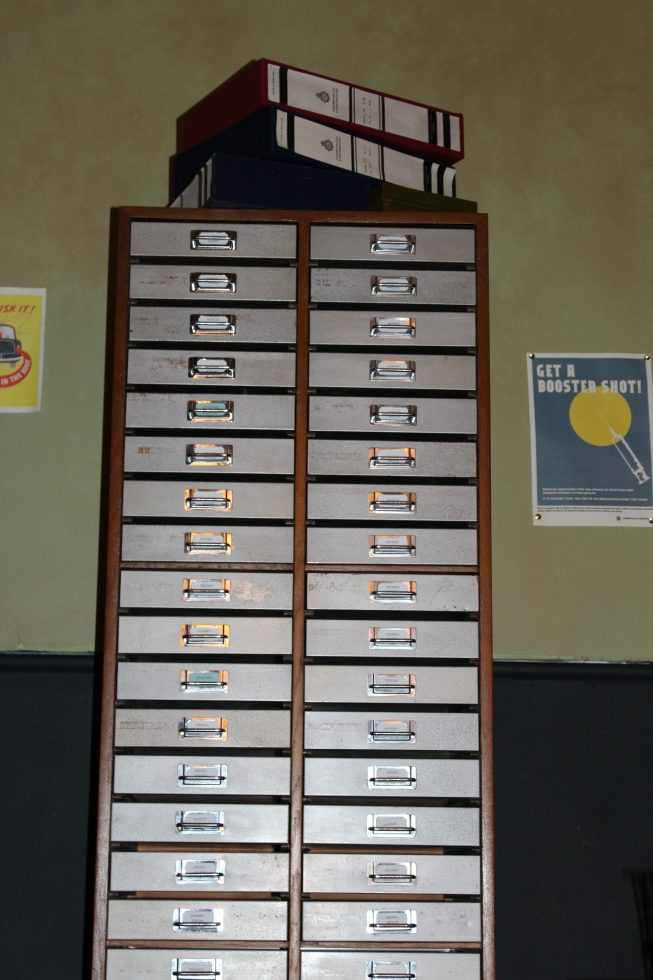
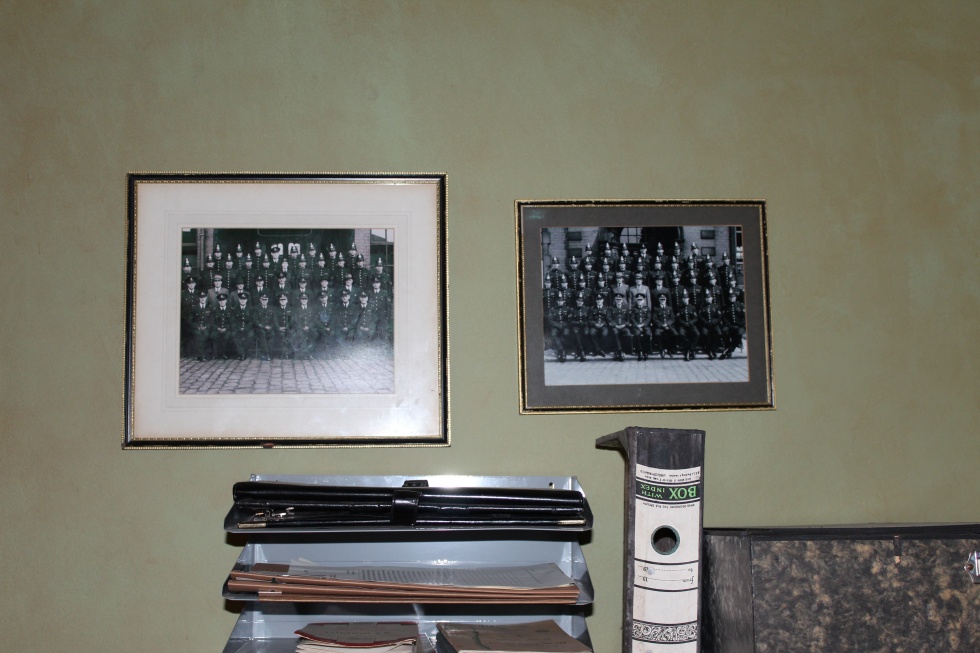


 DAMIAN: What it’s like hearing your script back for the first time at a readthrough, do the actors really get into character and is it you who reads the scene headings and action?
DAMIAN: What it’s like hearing your script back for the first time at a readthrough, do the actors really get into character and is it you who reads the scene headings and action?
RUSS: I love seeing everyone on the day — lots of hellos and how d’you dos — and it’s a privilege to hear them give life to the words. Sometimes if they’re in a puckish mood they’ll have a bit of fun with a line here or there. It’s lovely to hear this or that thing get a laugh in the room – cause you know – you’re playing your stuff to a pro crowd that knows a thing or two. But – there’s always a but – for reasons I’ll spare you, it’s always a very tough day. There’s a lot riding on it. A lot of money has been committed to making it – and a similar investment of time and hard work is resting on whether you’ve done your job properly. You’re usually only a couple of days from shooting – so it’s crunch time.
Either our sainted Casting Director Susie Parriss reads in the action, or the 1st AD for that particular film. You won’t always have a full cast. So some actors will ‘read in’ for other characters — which can be fun.
The seating plan is a bit like that for a Wedding. You’ve got a rectangle of desks around which sit the cast, execs, director, drama heads from the network, &c., and then chairs running around the walls – where the HoDs and their teams are – press department, runners, Production. About fifty to seventy people maybe.
Back in the gym, various members of the crew are now gathered together around a playback monitor to watch the CID scenes about to be shot and also to bask in the glow of a portable heater which has been brought in to combat the November chill. It’s a scene reminiscent of children sitting around a campfire listening to ghost stories and there’s sweets too – courtesy of hair and make-up designer, Irene Napier.
DAMIAN: Irene, is it true that you are one of the very few members of the crew to have worked on every single episode of Endeavour?
IRENE: Yes. Apart from the powers that be.
DAMIAN: That’s quite an achievement and rather something of an honour isn’t it?
IRENE: Yes. Quite often when a new producer takes over they take on a new crew, so I must be doing something right!
DAMIAN: You’ve actually been a fan of Morse since the original show began in 1987?
IRENE: Yes.
DAMIAN: Any favourite episodes that spring to mind?
IRENE: Goodness, I’m not sure. They’re all good.
DAMIAN: And what about Endeavour, do you have any particular favourites?
IRENE: ROCKET, SWAY, RIDE, CANTICLE, and CARTOUCHE.
DAMIAN: You’ve worked on many projects throughout the years including Monarch of the Glen, Rebus, The Inspector Lynley Mysteries, Bad Girls, Jekyll, Wire in the Blood, Garrow’s Law, Holby City, Shetland and One of Us to name but a few. A lot of your CV is made up detective and crime dramas so I’m wondering if you have a particular fondness for the genre?
IRENE: Not really it was just the way the work came in.
DAMIAN: Also, more than a few of these just happen to be set in Scotland! Hardly a coincidence I shouldn’t think?
IRENE: I actually live in Edinburgh!
DAMIAN: Yes, I know. And then you went to India!
IRENE: [Indian Summers] Was actually shot on Penang in Malaysia. We were there for six months. It was an amazing experience, but very hard work.
DAMIAN: Is travelling a significant factor in your decision to take on a project because they can involve working quite long hours can’t they?
IRENE: Sometime it’s a factor. It depends where you go. You don’t always get to see much of the country because of the hours.
DAMIAN: I also notice you worked on the ill-fated sequel to The Wicker Man but it did feature Clive Russell who I’ve interviewed for Ripper Street and Christopher Lee in a cameo role. What were these two great gentlemen like on set?
IRENE: Yes, that was quite a shoot! I didn’t, sadly, get to meet Christopher Lee as they shot that in London much later. But I’ve known, and have worked with, Clive many times over the years. Lovely man.
DAMIAN: And one more project you’ve worked on that I must ask you about before we move onto Endeavour is Rillington Place which I thought was very good indeed. What was the atmosphere like on that particular dark and dank project?
IRENE: It was as dark as the shoot.
DAMIAN: So, Endeavour, tell me how you got the job in the first place?
IRENE: I’d worked with director Colm McCarthy before and he suggested me to producer Dan McCulloch and we met and he gave me the job.
DAMIAN: What do you think it is that makes Endeavour so successful and well loved?
IRENE: I think the writing is wonderful and the cast are amazing.
DAMIAN: I’m always struck by the friendless of the cast and crew whenever I visit the set but there’s also an almost family bond between them as well isn’t there?
IRENE: Yes. That comes from the top and Shaun and Roger go out of their way to make sure everyone is welcomed and looked after.
DAMIAN: To what extent do you collaborate with Russ, the directors and producers, as well as people like the costume designers to get the right look for all the characters?
IRENE: We all work very closely together. Sometimes what’s written isn’t always possible, due to casting so we all collaborate to get it as close to what’s wanted.
DAMIAN: I imagine you’ve had quite a few stunt doubles over the years, are these a particular challenge from your point of view?
IRENE: Yes but they’re usually shot sympathetically to help us out.
DAMIAN: Abigail must be fun to work with, how would you describe Dorothea’s look?
IRENE: She’s a joy. I’d say it’s a casual look as befitting a working woman of the time.
DAMIAN: Can you describe the average day on set including what time you have to be here in the morning?
IRENE: We usually arrive at 6.45am in time to set up for the artists calls at 7.00. Then we sometimes all go on set, depending on how many artists there are, or someone will stay back to get the next wave ready. The day continues like that.
DAMIAN: How does it work then, do you do the make up for the main cast one by one in their individual trailers?
IRENE: We have a large make-up truck, set up with all our kit so that everything is on hand.
DAMIAN: Some of the cast must be a little grumpy first thing in the morning. Who’s often the grumpiest?
IRENE: They’re all a joy.
DAMIAN: Presumably you have to stay on set throughout the day?
IRENE: I go back and forwards to the truck, depending on what we’re shooting.
DAMIAN: I notice your bag full of sweets that you keep sharing with everyone. Given the fact that you’ve worked on Endeavour since the very beginning, do you have a certain motherly quality about you especially towards the younger and less experienced members of the crew?
IRENE: It’s always nice to have a little treat. Probably have a bit of motherly care.
DAMIAN: Irene, thank you very much indeed.
IRENE: You’re welcome.
The actors are now emerging from the green room and I hear that cough again followed by a clearing of the throat. Roger Allam doesn’t simply walk onto a set, he charges like a man on a mission. I’ve seen him before but once again, I’m reminded of a director whose work I’ve admired enormously over the years, the great Elia Kazan, a proponent of Method Acting alongside Lee Strasberg and director of such classics as A Streetcar Named Desire, Viva Zapata!, On the Waterfront and East of Eden. In his acclaimed autobiography, Kazan writes “‘Why are you mad?’ My wife asks me that, seems like every morning. Usually at breakfast, when my face is still wrinkled from sleep. ‘I’m not mad,’ I say. ‘It’s just my face’.
And so it is with the imposing Roger Allam whose face cannot help but emote absolute intensity and a certain level of ferocity – and that’s before the cameras start to roll – it’s just his face. This is a man you can really believe would have your cobblers for a key fob if you did anything to upset him. Of course, and in complete contrast, everyone tells me – cast and crew alike, that he’s an utter joy to work with and has a wicked sense of humour. Maybe he’ll crack a joke or two later but I won’t be banking on it any time soon.
Shaun Evans also walks by with the usual spring in his step. It’s almost jaunty. As though each step or two forward is a prelude to a little dance number. He immediately starts laughing and joking with the crew. This is the third time that I’ve witnessed him filming and he’s always like this. I like to imagine him as something of a Flâneur as he saunters and strolls around saying hello to everyone. Shaun shows a genuine interest in everyone he meets and has a keen ear for accents and dialect. On the occasion of our first meeting, for example, he instantly knew I was from Stoke. Indeed, chip-eaters all of us, Liverpudlian and Stokie accents are not all that dissimilar in some respects.
And good God man, it’s Anton Lesser! I don’t know if, in addition to Endeavour, you’ve seen many of his other great screen performances such as the Archbishop of Canterbury in The Palace, the Duke of Exeter in The Hollow Crown, Prime Minister Attlee in A United Kingdom, Sir Thomas More in Wolf Hall and, of course, another Prime Minister, this time Harold Macmillan in The Crown and Qyburn in Game of Thrones – two of the biggest shows on the planet right now – but he really is every bit as mercurial and enigmatic in person as he is on screen.
As the three of them discuss their next scene in CID with the director, Russ and I chat to Dakota Blue Richards who’s also just arrived on set. She’s wearing a beautiful long camel coat which the costume designer, Mary-Jane Reyner picked up at a vintage shop in Brighton. Also, having decided to go back to her own natural hair colour before shooting began, Dakota’s also wearing a wig. Indeed, the wig and the cut of the long coat combined, she gives off a cool blonde femme fatale vibe as though she’d stepped out of a Film Noir movie from the 1940s or 50s. We talk about a project that I’d better not mention here just yet but you can read my (previously posted) interview with her here.
We join some of the cast and crew round the monitor to watch as the CID scenes are recorded. Producer Neil Duncan (see previously posted interview) tells me, presumably in reference to the way I’m dressed, that I’d make a good CID officer. He doesn’t offer me a part though. Shame, because I’m sure I’ve heard the name DI Barcroft somewhere before. Talk then turns to what’s on today’s menu (I think I told you about the Shepherd’s Pie, Vegetable Burrito and chips!) and Lewis Peek (see previously posted interview) asks Russ what the difference is between Cottage and Shepherd’s Pie. I resist the temptation to add that an easy way to remember Shepherd’s Pie is to recall a line from Dr Lecter: ‘You will let me know when those lambs stop screaming, won’t you?’
After lunch we visit the art and props department which strikes me as something of a cross between Q’s workshop and the North Pole. This is the magical place where the elves make pretty much everything we see on screen that can’t be sourced from an antiques fair or car boot sale. So every time you see a tax disc in the car window, various police photofits or framed photos on someone’s desk, a packet of cigarettes or a bottle of booze, various letters and newspapers (the articles still need to be written even if you can’t make out way they’re about on screen) and even carrier bags, all these props need to be made by someone and this is where you’ll probably find them.
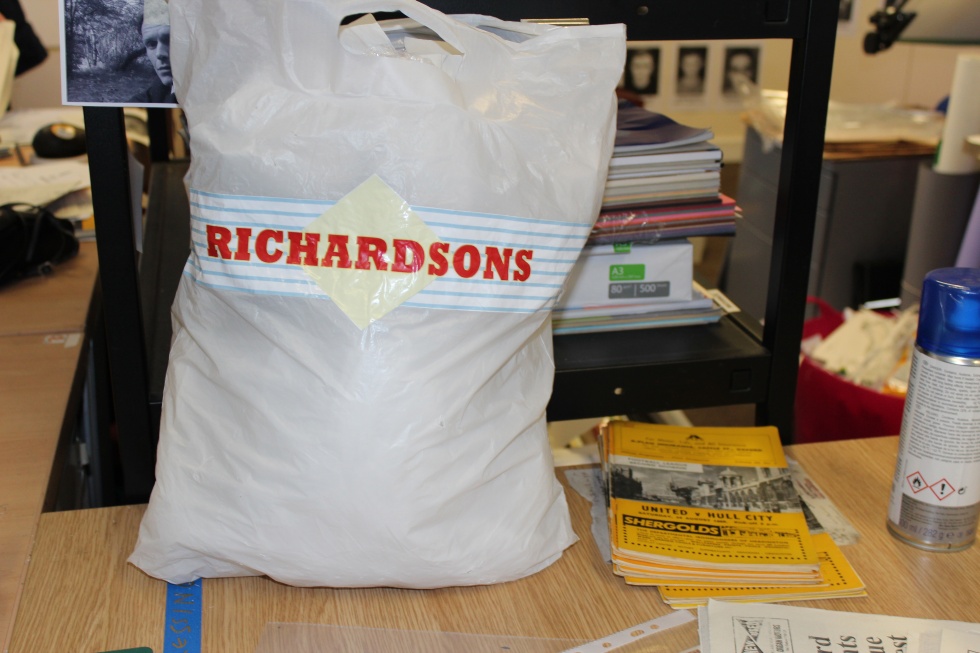

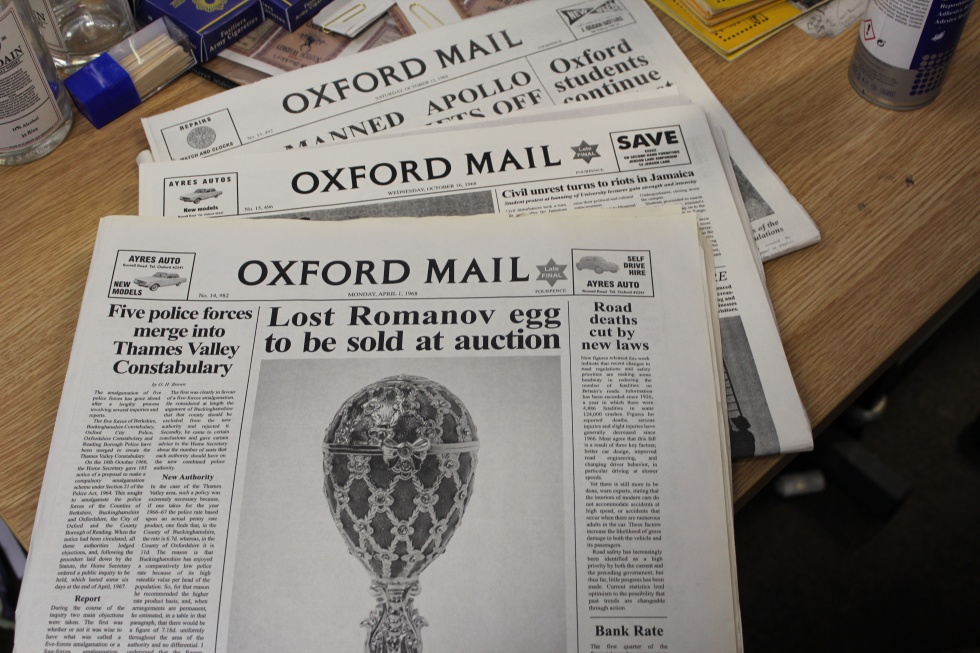
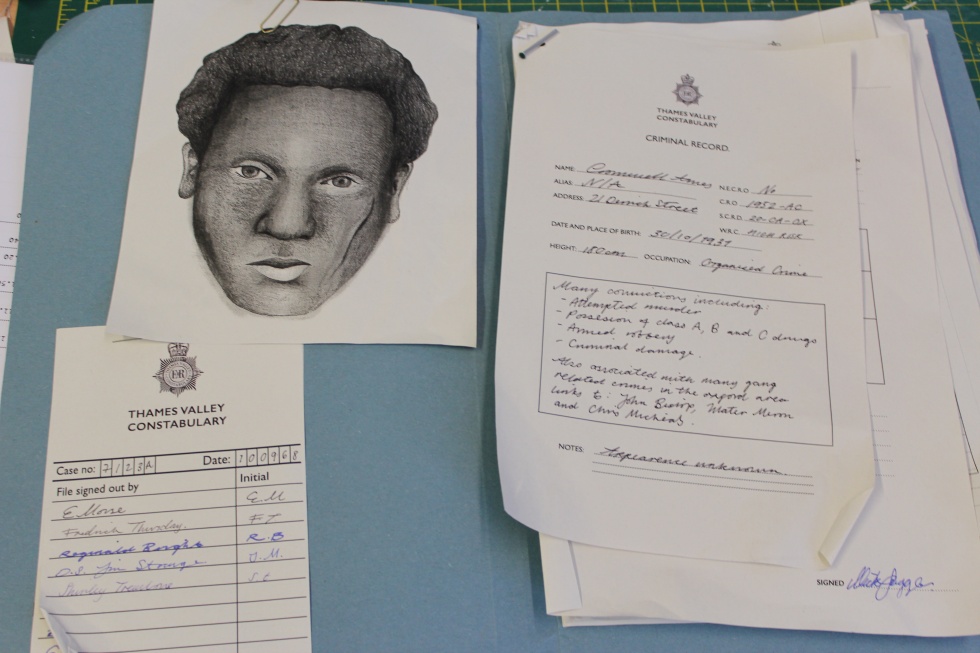 When he’s not driving around in a bus with the heads of department and key crew during what they call a “tech recce”, scouting every single location or joining his team for shopping trips to buy furniture and furnishings, you’ll also sometimes find production designer Paul Cripps here too. (see previously posted interview) Various artists have contributed to the design of the show over the years so while sets including CID, Max’s mortuary and the Thursday house will pretty much remain the same each series, every new set that we haven’t seen before including the Crossroads Motel (I used to love Benny Hawkins), interiors of the Roxy Cinema, Endeavour and Strange’s shared maisonette, these and so many more all need to be designed, actually built from scratch and then furnished.
When he’s not driving around in a bus with the heads of department and key crew during what they call a “tech recce”, scouting every single location or joining his team for shopping trips to buy furniture and furnishings, you’ll also sometimes find production designer Paul Cripps here too. (see previously posted interview) Various artists have contributed to the design of the show over the years so while sets including CID, Max’s mortuary and the Thursday house will pretty much remain the same each series, every new set that we haven’t seen before including the Crossroads Motel (I used to love Benny Hawkins), interiors of the Roxy Cinema, Endeavour and Strange’s shared maisonette, these and so many more all need to be designed, actually built from scratch and then furnished.

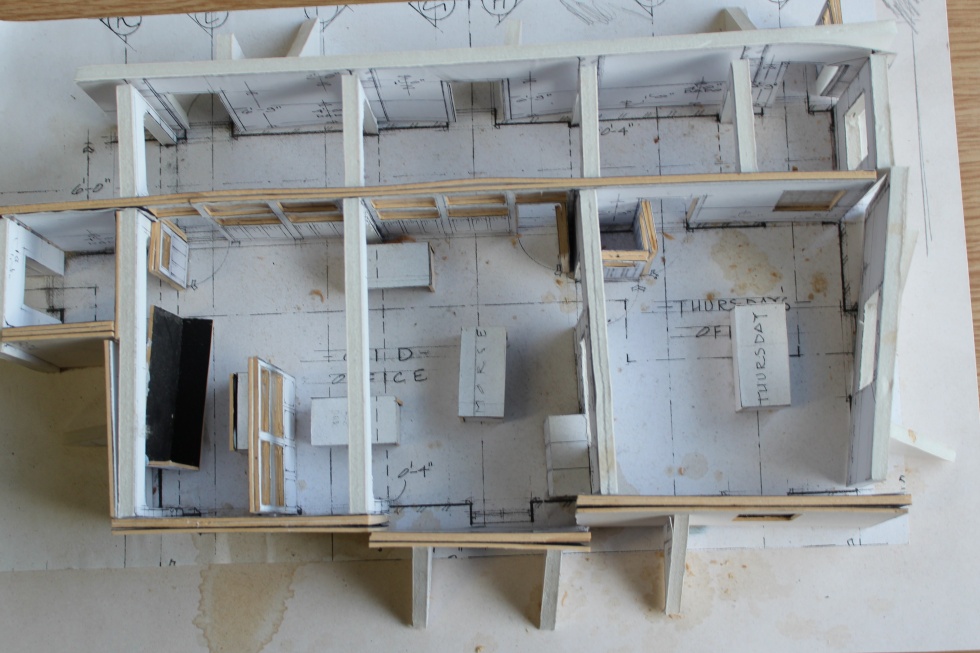


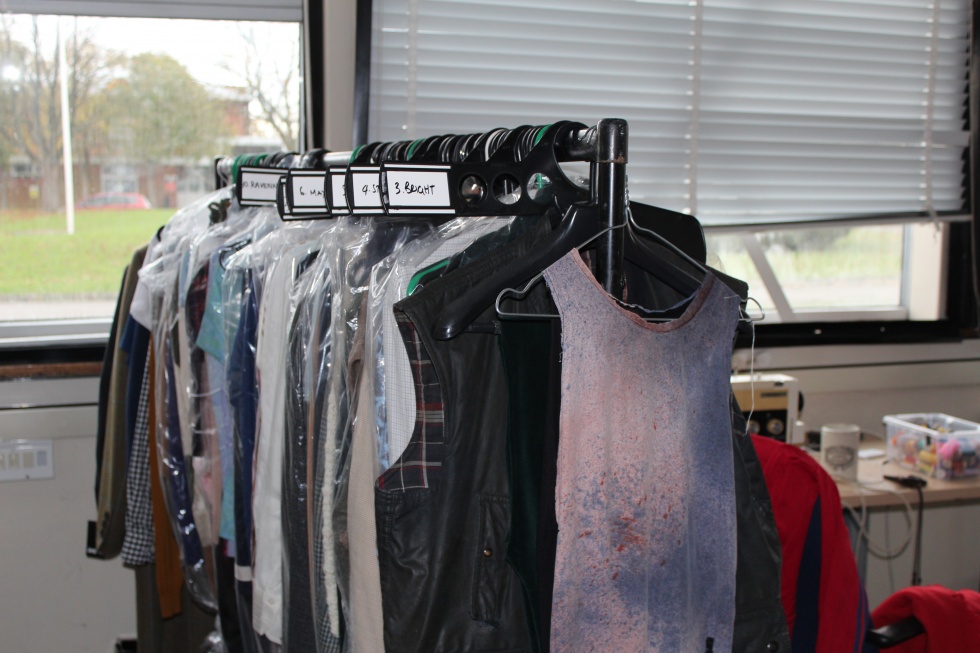
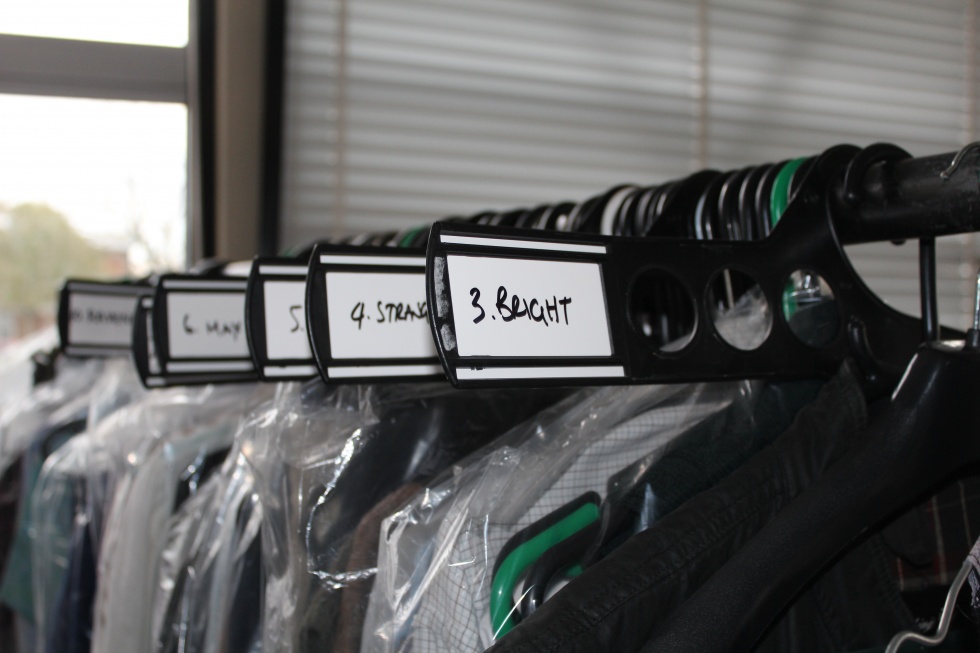 Although I’m not allowed to try any of them on, we pass through the costume department on our way to somewhere very special indeed. If the art and props department is where all those wonderful artefacts are designed and made, this is their graveyard where they are laid to rest and kept just in case they ever need resurrecting again in the future. It’s either an Aladdin’s cave of interesting and curious delights if you’ve poured over every single detail of the show as I’ve done for the past few years, or a sixties jumble sale if you’re not quite so obsessive.
Although I’m not allowed to try any of them on, we pass through the costume department on our way to somewhere very special indeed. If the art and props department is where all those wonderful artefacts are designed and made, this is their graveyard where they are laid to rest and kept just in case they ever need resurrecting again in the future. It’s either an Aladdin’s cave of interesting and curious delights if you’ve poured over every single detail of the show as I’ve done for the past few years, or a sixties jumble sale if you’re not quite so obsessive.
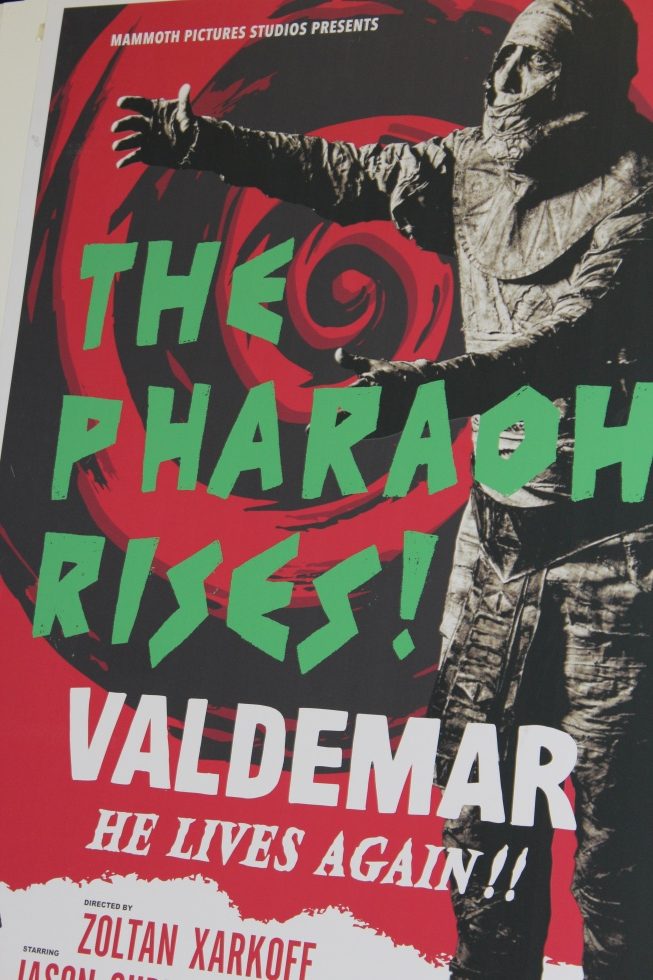
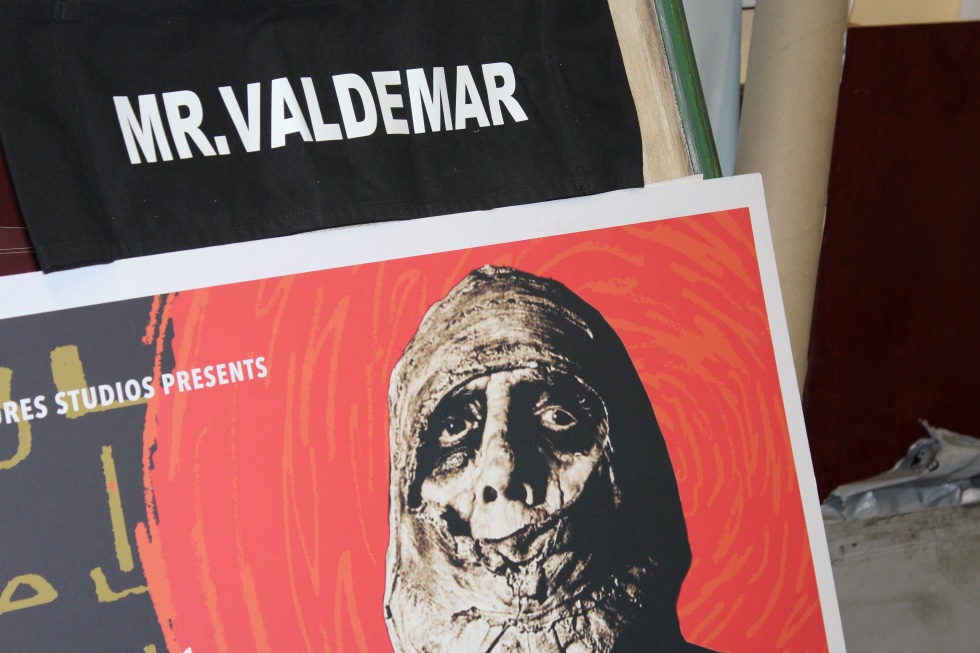





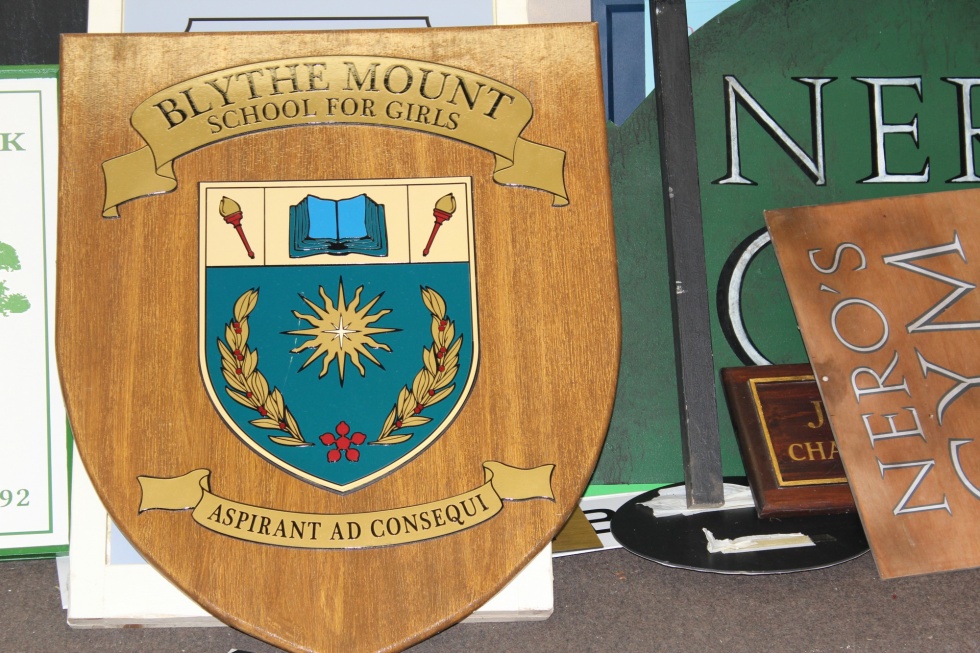

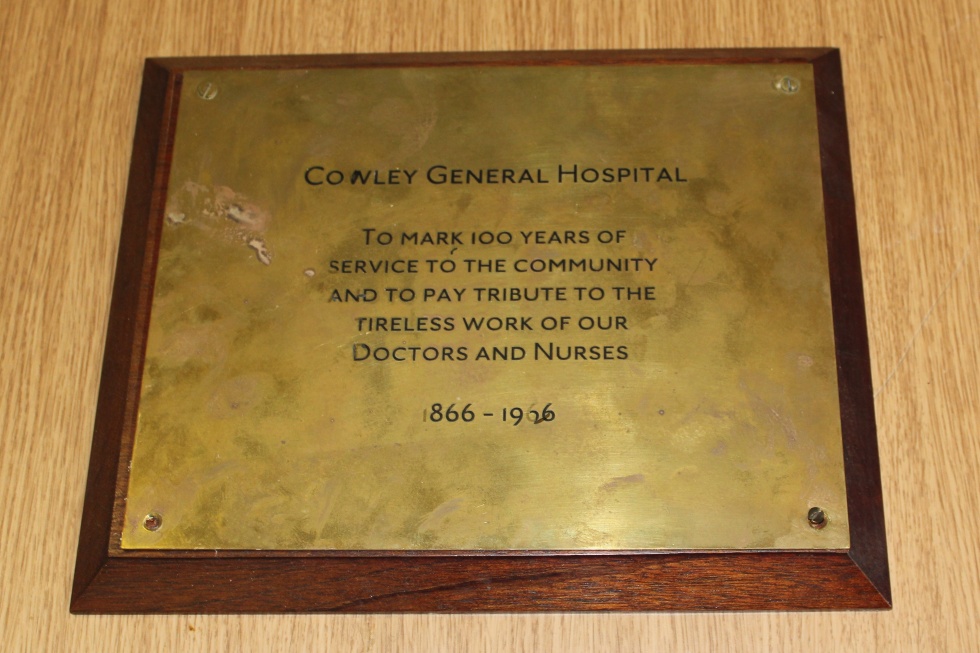


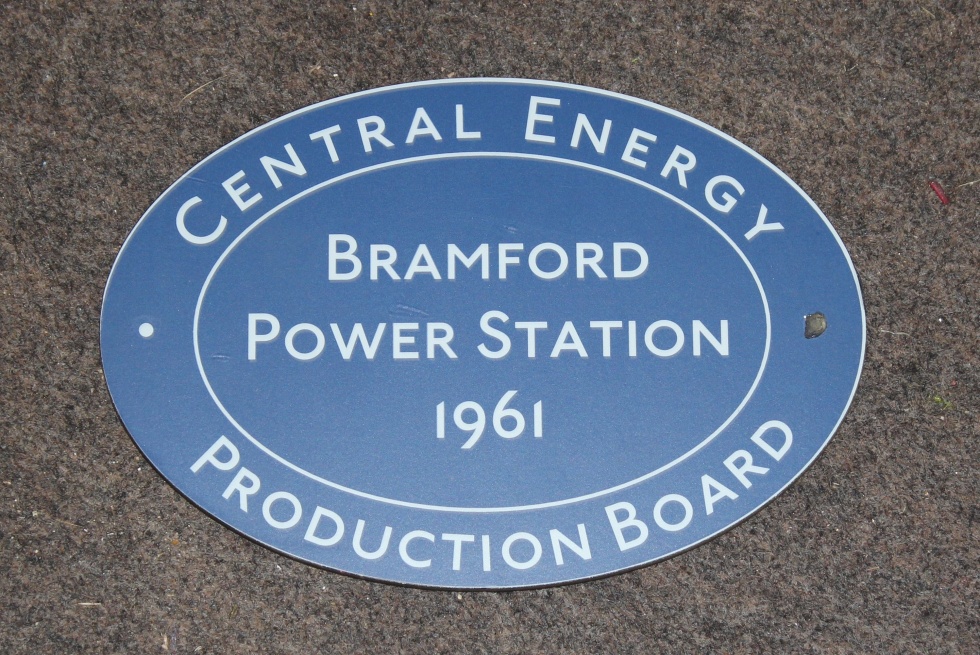
 Once again however, time is of the essence as all these treasures are being packed away into boxes and the scene will soon resemble the closing shot from Raiders of the Lost Ark. Indeed, misquoting Indiana Jones ever so slightly, I say to Russ, as I also did to Paul Cripps, that all this stuff belongs in a museum. He then shows me something that truly does belong in a museum or gallery at least…
Once again however, time is of the essence as all these treasures are being packed away into boxes and the scene will soon resemble the closing shot from Raiders of the Lost Ark. Indeed, misquoting Indiana Jones ever so slightly, I say to Russ, as I also did to Paul Cripps, that all this stuff belongs in a museum. He then shows me something that truly does belong in a museum or gallery at least…
Some of you may recall a piece I wrote last March as a tribute to Colin Dexter in which I mentioned that I missed out on meeting him by a mere 24 hours. Well, Russ rifles through a stack of large framed pictures and shows me the portrait of Colin that was on the wall of Dorothea Frazil’s office at the Oxford Mail. I suppose this is as close as I’ll get to the great man. In contrast to the rest of the day’s excitement, this is a reflective and beautiful moment albeit one touched with much poignancy.
DAMIAN: That evening with Colin at the Randolph Hotel where the two of you met to discuss doing a one-off special prequel to celebrate the silver anniversary of Inspector Morse must seem like a very long time ago now?
RUSS: Perhaps – I don’t know. The older one gets, things that happened a decade ago feel like they happened yesterday. So…
DAMIAN: Having Colin’s feedback and input for at least the first couple of series, do you ever stop to wonder what he’d have to say regarding the scripts as you write them now?
RUSS: That way madness lies. We don’t have him beside us any more. I just try to stay true to what we originally set out to do — which was to fill in the blanks.
DAMIAN: When was the last time you saw or spoke to Colin?
RUSS: At Blenheim – appropriately enough. It was where my association with his creation began, as the palace features very heavily in The Way Through the Woods. Me, Shaun and Dan McCulloch did a Q&A with Colin as part of a literary festival held there. And afterwards we spent a very happy hour or so in the cafeteria with him – talking poetry mostly. Passers-by stopped at the table to wish him well. He was in his element. Not in the best of health – but twinkling brightly, as always. And then it was time for him to go. So — the last image I have of Colin is of him taking Shaun’s arm for support as he made his way to a waiting car. It sounds like a movie cliche, but that’s how it was. The creator and the youngest incarnation of his creation, arm in arm for one last time. To the end. Dolly back, and… Fade out.
 We’re now outside the main building having a smoke again and there’s another fellow also here wearing a fetching maroon tank top. I walk over to him, shake his hand and say, ‘Hello, matey’. Really rather embarrassing, I know, and yet I find I can’t help myself. He looks at me as though I’ve been let out for the day with Russ acting as my primary caregiver but after a gentle reminder that I’m the chap who did an interview with him a few years ago, he seems to breath (an ever so slight) sigh of relief. The character of Strange has evolved quite a bit since my first interview with Sean Rigby back in April 2014 so we discuss some of the most significant changes.
We’re now outside the main building having a smoke again and there’s another fellow also here wearing a fetching maroon tank top. I walk over to him, shake his hand and say, ‘Hello, matey’. Really rather embarrassing, I know, and yet I find I can’t help myself. He looks at me as though I’ve been let out for the day with Russ acting as my primary caregiver but after a gentle reminder that I’m the chap who did an interview with him a few years ago, he seems to breath (an ever so slight) sigh of relief. The character of Strange has evolved quite a bit since my first interview with Sean Rigby back in April 2014 so we discuss some of the most significant changes.
DAMIAN: In terms of how Strange has developed, the first thing that springs to mind are the events towards the end of NEVERLAND (S2: E4). While I appreciate that he was someone, at that stage of his development at least, who was more of a conformist and rule bound, isn’t it still unforgivable that he hesitated for so long and initially chose to follow ACC Clive Deare’s orders rather than help his friends Endeavour and Thursday at Blenheim Vale?
SEAN: I think unforgivable may be a tad extreme. Strange made the right decision in the end and, hopefully, that is what counts most.
DAMIAN: I think that part of the reason that Strange is such a fascinating character is that he’s often got this deadpan and almost innocently oblivious quality on the one hand (indeed, you described him as having something of the Auguste clown about him in our original interview) and yet, we’ve also seen a more cunning, calculating and complicated side to him with regards to climbing up the ladder in recent years haven’t we?
SEAN: Yes and I think that is all part of Strange becoming a more rounded character as the story progresses. It’s something we’ve seen with all the supporting characters, the duality of their personalities. Bright being impulsive and heroic. DeBryn’s heart and sombreness. Those are the two examples that spring to mind most readily.
DAMIAN: As someone who has been wanting to learn more about the background and personal lives of characters such as Bright, Max and, indeed Strange, I was delighted to see that Russ has finally written some scenes for you that shed some light on this at last. Is this something you’ve also pushed for?
SEAN: I’m not really the pushing sort. “You know what this needs? More of me!” It has been fun exploring how Strange inhabits different spaces, certainly. We all want to know what people get up to behind closed doors and what’s in their shopping trolley.
DAMIAN: Indeed, I was greatly amused and delighted to learn that in the first film of this year’s run that Endeavour has moved in with Strange and although they’re not quite sharing a bed together, isn’t their unlikely partnership beginning to resemble Laurel and Hardy or Morcambe and Wise?
SEAN: We had a great deal of fun filming those scenes. I don’t think their cohabitation will ever reach the harmonious heights of Morcambe and Wise making breakfast together though.
I’m not sure who would be who. I do have short, fat, hairy legs so make of that what you will.
DAMIAN: What’s with the trombone all of a sudden?
SEAN: Ah, the trombone!
DAMIAN: Do you play?
SEAN: Not in the slightest. I used to play the cornet as a kid but I am reliably informed by my parents that I was utterly pants. I had a good whack at the trombone regardless. I produced a sound akin to an asthmatic goose being sat on.
DAMIAN: I absolutely loved the scene in ARCADIA (S3:E2) when Strange, once again, completely genuine but oblivious gives Endeavour the James Last album. Since you’re a young lad, do you even know who James Last is and appreciate how funny it is to give it to someone like Endeavour?
SEAN: I made myself aware after reading the script and I can’t say it lingered on my iPod long afterwards. No offence intended to any James Last fans out there. Shaun is hilarious in that scene, like a young boy unwrapping an itchy jumper from his Gran on Christmas morning.
DAMIAN: And isn’t it fantastic moments like these that economically sum up almost everything we need to know about Strange and his polar opposite relationship with Endeavour?
SEAN: Absolutely. They find each other, for different reasons, quite hard to figure out at times.
DAMIAN: Naturally Endeavour turns his nose up at the gift and in the same episode, when the two are at the pub, he also complains about the pint Strange has got him for being too cloudy and also mocks him for drinking Double Diamond lager. Endeavour is really very unkind towards Strange isn’t he?
SEAN: Yeah, the ungrateful git. It is true to life though, isn’t it? When we feel at odds with the world, or hard done by, we take out our frustrations on those closest to us. Morse’s options are fairly limited in that regard.
DAMIAN: How do you think the relationship between the two has developed since Strange was first introduced in GIRL (S1:E1)?
SEAN: It’s certainly had its ups and downs. There’s more of a shorthand between the two. Not too much, mind.
DAMIAN: And we must mention Strange’s legendary tank tops which he seems to wear regardless to weather conditions as though his mother still dresses him. Is it fair to say he’s a bit drab and frumpish before his time?
SEAN: I think that would be entirely fair to say. The swinging 60’s really passed Strange by where fashion is concerned. Probably where everything else is concerned too!
DAMIAN: Is the maroon tank top his particular favourite?
SEAN: As it’s probably the least flattering of the lot I’m going to say yes.
DAMIAN: In a fantastically tense scene between two men with such loyalty and respect for each other, Endeavour doesn’t approve of Strange punching the informant Bernie Waters in CODA (S3:E4). Do you think that Strange is much closer to, and influenced by the methods of Thursday than Endeavour could ever be?
SEAN: I think by dint of his intellect and abilities, Endeavour stands alone. That’s not to say that there isn’t a great deal Morse can’t learn from Thursday, but he certainly has a few more avenues available to him when it comes to an investigation. Strange is going to take all the help he can get.
DAMIAN: Finally, and I’m not sure who told me this although it was probably Russ, is it true that you regard performing in scenes with Roger Allam and Anton Lesser as masterclasses in acting?
SEAN: I think that was in reference to one particular scene, series 3 if memory serves, where they’re both having a bit of a hoo-ha in Thursday’s office. I had to come in towards the end of the scene and deliver a bit of news of some sort. From rehearsals to the last take I had my nose pressed against the glass in total awe of the pair of them. Not just the acting but the way they communicated with each other, from one actor to another. They both had the goal of making the scene the best it could be, playing together in the purest sense. Ask any actor worth a sniff and they’ll tell you that there is nothing more thrilling than that.
Obviously, apart from that one particular scene, they’re both normally crap.
DAMIAN: Sean, thank you matey!
SEAN: A pleasure!
It’s late now. It’s getting dark and Russ reminds me that I have a train to catch so I’d better shake a leg. There’s been a last-minute alteration to the shooting schedule and so the order in which some of the scenes are shot have changed which means everything will run slightly later than planned and I won’t get to speak to some of the other cast now. However, there might just be time for one more hello and it’s funny because you’d think that with all the questions I’ve asked various members of the Endeavour cast and crew over the years, that I would be more than capable of answering a very simple question myself. Not so.
Russ has arranged for me to have a photo with a hero of mine; a gentleman who asks in that rich and aristocratic voice of his, ‘With or without glasses? – Do you want me as Bright or as Anton?’ I’m flummoxed! Perplexed! Discombobulated! They say never meet your heroes and they’re probably right. Not because there’s anything wrong with them, rather the chances are, if you’re anything like me at least, that you’ll make a complete arse of yourself. After the longest pause in Anton’s lengthy career, I finally make my decision. Without the glasses because, of course, Lesser is always more.
 I bid farewell to this wonderful and magical place. Indeed, throughout the day, people have asked if I’m enjoying myself and I’ve given the same response each and every time: it’s like Disneyland to me. Walking back to the car, I consider that must make my host Uncle Russ – grand master and architect of all this beautiful madness.
I bid farewell to this wonderful and magical place. Indeed, throughout the day, people have asked if I’m enjoying myself and I’ve given the same response each and every time: it’s like Disneyland to me. Walking back to the car, I consider that must make my host Uncle Russ – grand master and architect of all this beautiful madness.
DAMIAN: Executive producer and managing director of Mammoth Screen, Damien Timmer, isn’t with us this time (perhaps another bout of plot vertigo) but to what extent do the two of you keep in touch throughout the shoot when he has so many other hit shows to oversee including Victoria and Poldark?
RUSS: He is a man of seemingly inexhaustible energy — so, yes — he is across every second of Endeavour. Every story choice. Every creative decision. His level of care for all his creative offspring never ceases to amaze.
DAMIAN: I’m sure it will prove fruitless to ask you about 1969 and the possibility of a sixth series. So instead, can you take me through the process of what usually happens with Mammoth Screen and ITV immediately after a series ends and their decision to commission another?
RUSS: In the beginning, at least after the pilot, which got a green light for going to series the day after transmission, it was a case of see what the figures were. The same as any other show, pretty much. As ever – our future is in the hands of the network, and it’s for them to make any announcement on 1969.
DAMIAN: Have you made plans beyond Endeavour and thought about what you’d like to write when the show does end?
RUSS: KBO as Churchill used to say. Turn the ‘FOR HIRE’ light back on the taxi. There are a number of things in development. Who knows? I’ve been enormously fortunate and had a decent run — far more than a bear of very little brain could have hoped to dream.
But I’m certainly eyeing the light. There’s only so much play left in the day. Whether one’s innings ends in a declaration or the umpire calling stumps remains to be seen. Either way, the pavilion awaits. Quite right too. Get out of the way of the up and comers. Can’t wait to see what they’re going to do.
DAMIAN: What can audiences expect from this final film of series 5?
RUSS: We’re going back to school. Having looked at a Girls’ school in NOCTURNE — this time we’re having a look at a Boys’ public school. Endeavour gets to walk in someone else’s shoes for a while. A window onto another possible life that’s been half in his mind for a while.
There’s a sense of change in the air — and with half a century since the end of the Great War, we’re bringing some of the underlying themes of 1968 to a close. Fifty years further on, I think it struck all of us just how much we’re still asking the same questions about ourselves. Questions of national identity, and our place in the wider world. Post-imperial – post-colonial – post-industrial – post early for Christmas. Much in which to take pride. Much of which to be ashamed. But one post survives. The post war dream.
When the chips are down, and backs are to the wall, I think you’ll always see us at our best, and catch some glimpse of Thursday’s Generation – a generation that gave so much, and asked for so little. I believe that still lives on in the inhabitants of these islands. Though it’s sometimes hard to see, there is – and will ever be – more that unites us than divides us. Like the denizens of Cowley nick, we stand or fall together.
DAMIAN: Since Endeavour HQ has been based here for the last few years, to what extent are you nostalgic or sentimental considering they’ve already started packing things away and Team Endeavour will never be based here again?
RUSS: It’s just a ramshackle, rather eccentric, collection of buildings. The people make it what it is. It’s been a tremendously useful space – in terms of production – and has saved our bacon more times than I can remember. Pick-ups; sleight of hand; poor-man’s process; reshoots. There’s very little of it we haven’t disguised, repurposed, or otherwise pressed into service.
But – working in this industry – as I think anyone would tell you – farewells are hard-wired into the process. There is always something of the rag-tag-and-bobtail army of vagabonds and strolling players to it. You come together for short periods of time and operate at a madly high level of intensity and concentration. And then it’s over. You fold up the tents and move on. But it’s like that every day – wherever we are. We use every second of available time — right down to the wire. As cut off time looms into view – there’s a lot of looking at watches to make sure we don’t go over and incur huge costs. So when we do wrap – it’s straight into striking sets, and organising the breakdown and loadout of kit.
Across the last days of a series — as each of our principal characters finishes their filming, there’ll be an announcement of “that’s a series wrap for Caroline, or Sara, or Abigail or Anton” – and the tradition is that cast and crew will give them a round. Of applause, obviously. Not the full metal jacket variety. Just to show appreciation for their hard work.
I don’t come out a lot — though I think on this run, I’ve probably been out more than on any other; usually as chaperone to interested parties. But I always try to find a moment – usually at lunch or before we’ve turned over – to stand alone on the set and just absorb some of the atmosphere. That ‘early morning madness’ of the ‘magic in the making’. ‘Whispered conversations in overcrowded hallways’ I’m all too familiar with.
At the end of a run, when the 1st AD announces – ‘That’s a Series Wrap’ – you hug your comrades hard – and maybe you’ll see them again, maybe you won’t, but you carry them in your heart and mind always. It’s interesting – circus and fairground folk never say ‘Goodbye’ — it’s always ‘See you down the road.’
A ramshackle, rather eccentric, collection of buildings or not, I still find it sad to think that this place will soon be demolished and turned into an housing estate. Time and tide wait for no man but I’d like to think that a plaque will be installed here one day and perhaps this love letter to the show will suffice until then. Despite the melancholy however, I don’t get over emotional, it’s just that I have something in my eye – bit of coal dust I expect. And, as Russ drops me back at the train station, I hear Rachmaninoff’s Piano Concerto No. 2 once more.
See you down the road…
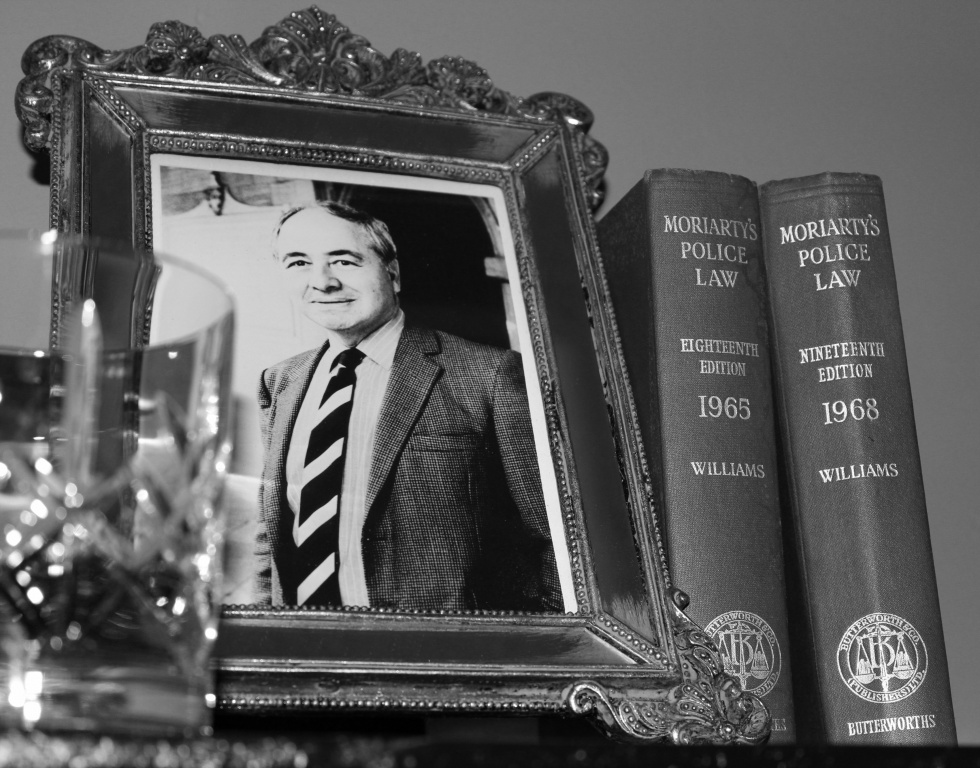 Article, interviews & photographs copyright © Damian Michael Barcroft 2018
Article, interviews & photographs copyright © Damian Michael Barcroft 2018









